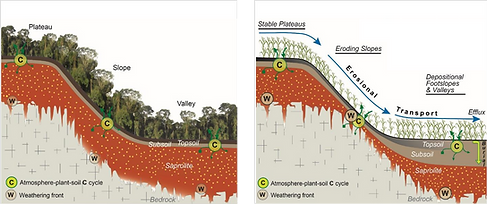

TropSOC
Funded by DFG, within the Emmy Noether Programme
Tropical soil organic carbon dynamics along erosional disturbance gradients in relation to variability in soil geochemistry and land use

Photo: Sebastian Doetterl
Background and motivation
The response of soils to disturbance by erosion is one of the great uncertainties in predicting greenhouse gas fluxes from soils to the atmosphere and hence future earth system dynamics. This is largely due to a lack of data in “remote” areas, such as tropical Africa, but also due to an inadequate transfer of knowledge from smaller to larger scales. In particular, it is unclear how C dynamics differ in the Tropics compared to the temperate climate zones, from which most of our mechanistic process understanding on C cycling is derived. It is important to fill this knowledge gap since tropical ecosystems provide services with global importance, such as C storage in plants and soils, soil fertility, plant productivity and ultimately food supply.
Objectives
The main objective of the proposed TROPSOC project is to develop a mechanistic understanding of C sequestration and release in the soils of Tropical Africa, studied in the Eastern part of the Congo Basin. This region provides a unique combination of (i) geologically diverse parent material for soil formation and (ii) different levels of disturbance by human activity, taking place under a humid, tropical climate regime, where pristine forests are converted into agricultural land at high rates. TROPSOC will make a significant contribution to answering the following questions:
-
How will nutrient fluxes and C allocation between soils, plants and the atmosphere evolve and differ in tropical systems in relation to the controlling factors: mineralogy, topography and vegetation?
-
How does geochemistry control, interact with or mediate the severity of erosional disturbance on C cycling in the critical zone of tropical soils?
-
How can we model the mechanisms controlling tropical soil C dynamics in a spatially explicit way?
Output
TROPSOC will make a significant contribution to improving our understanding of the factors that give rise to the spatial distribution and fate of C of tropical soil systems. By the end of the project, we will have a better understanding of the factors that give rise to the spatial distribution and fate of carbon in tropical soils. We will have produced benchmark data products and modeling tools that will help to bridge the gap between plot scale process understanding and large scale modeling of tropical C cycling. This will ultimately help to reduce the uncertainty associated with terrestrial C fluxes and the response of soils to disturbance, which is one of the greatest uncertainties in current Earth System Models and Ecosystem Service assessments.

Typical landscape in South-Kivu near Bukavu dominated by agricultural activity. Photo: Mario Reichenbach

Heavily eroded slopes near Bukavu in South Kivu. The soil is completly eroded down to the basaltic bedrock, due to pronounced agricultural activity and missing plant coverage. Photo: Mario Reichenbach

Mark to locate the buried data logger in the forest again. Photo: Mario Reichenbach

Typical landscape in South-Kivu near Bukavu dominated by agricultural activity. Photo: Mario Reichenbach
Data
Download the first version of the TropSCO database here.
Publications
Bukombe B., Fiener P., Hoyt A., Doetterl S. Controls on heterotrophic soil respiration and carbon cycling in geochemically distinct African tropical forest soils. Soil Discussion (pre-print). https://doi.org/10.5194/soil-2020-96.
Doetterl, S., Bukombe, B., Cooper, M., Kidinda,L., Muhindo, D., Reichenbach, M., Stegmann, A.,Summerauer, L., Wilken, F., and Fiener, P.: TropSOC Database, Version 1.0, GFZ Data Services, https://doi.org/10.5880/fidgeo.2021.009, 2021.
Doetterl, S., Asifiwe, R., Baert, G., Bamba, F., Bauters, M., Boeckx, P., Bukombe, B., Cadisch, G., Cooper, M., Cizungu, L., Hoyt, A., Kabaseke, C., Kalbitz, K., Kidinda, L., Maier, A., Mainka, M., Mayrock, J., Muhindo, D., Mujinya, B., Mukotanyi, S., Nabahungu, L., Reichenbach, M., Rewald, B., Six, J., Stegmann, A., Summerauer, L., Unseld, R., Vanlauwe, B., Van Oost, K., Verheyen, K., Vogel, C., Wilken, F., and Fiener, P.: Organic matter cycling along geochemical, geomorphic and disturbance gradients in forests and cropland of the African Tropics – Project TropSOC Database Version 1.0, Earth Syst. Sci. Data Discuss. [preprint], https://doi.org/10.5194/essd-2021-73 , accepted, 2021.
Kidinda LK, Olagoke FK, Vogel C, Kalbitz K, Doetterl S. Patterns of microbial processes shaped by parent material and soil depth in tropical rainforest soils. SOIL DISCUSSIONS (pre-print). https://doi.org/10.5194/soil-2020-80.
Reichenbach M., Fiener P., Garland G., Griepentrog M., Six J., Doetterl S. The role of geochemistry in organic carbon stabilization in tropical rainforest soils. Soil 7: 453-475. https://doi.org/10.5194/soil-7-453-2021 .
Summerauer L., Baumann P., Ramirez-Lopez L., Barthel M., Bauters M., Bukombe B., Reichenbach M., Boeckx P., Kearsley E., Van Oost K., Vanlauwe B., Chiragaga D., Heri-Kazi A.B., Moonen P., Sila A., Shepherd K., Bazirake Mujinya B., Van Ranst E., Baert G., Doetterl S., Six J. Filling a key gap: a soil infrared library for central Africa. SOIL Discussion (pre-print). https://doi.org/10.5194/soil-2020-99
Wilken F., Fiener P., Ketterer M., Meusburger K., Muhindo D.I., Van Oost K., Doetterl S. Assessing soil erosion of forest and cropland sites in wet tropical Africa using 239+240Pu fallout radionuclides. Soil 7:399-414. https://doi.org/10.5194/soil-7-399-2021 .


